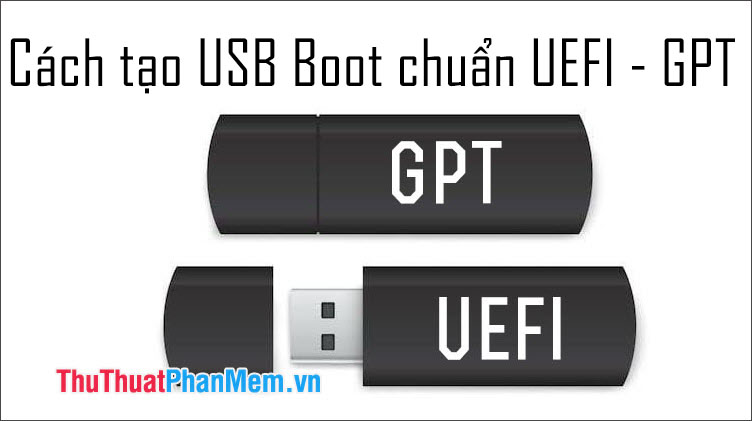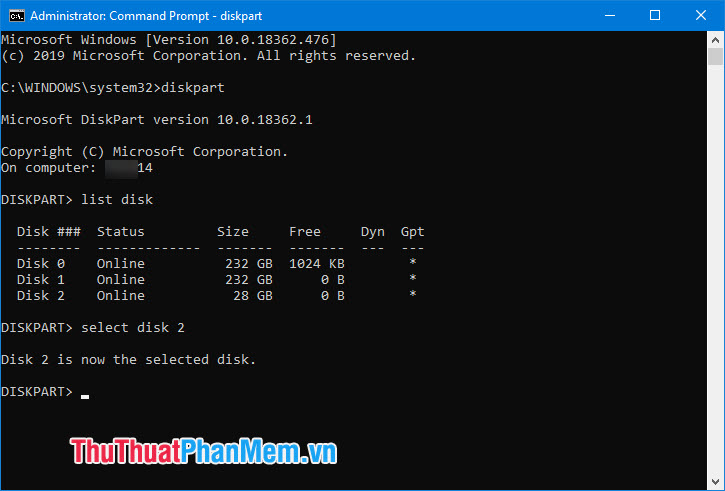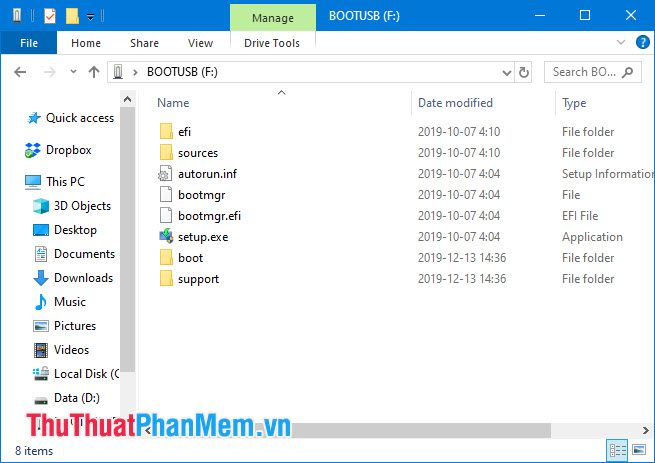How to create USB BOOT standard UEFI - GPT standard
Create a rescue USB, USB boot helps us to use the computer and access in case of computer failure win or virus. However, for booting Windows to succeed, the job of creating a USB boot is very important and we must determine whether the USB Boot is a UEFI - GPT or Legacy - MBR standard before proceeding to create an archive.

In the following article, TipsMake.com guides you how to create the UEFI - GPT standard USB Boot quickly and easily.
Method 1: Create USB UEFI Standard Boot - GPT manually
In this way, we create usb boot by formatting and setting the usb to UEFI - GPT standard and copy the Windows installer to the computer. Proceed as follows:
Step 1: You connect the USB to the computer and run CMD with Administration permission. On Windows 7, press Windows + R => cmd and Enter, and on Windows 10, search and search for the keyword cmd => right-click and select Run as administrator .

Step 2: You continue to enter the following command and press Enter .
diskpart

Step 3: Enter the following command and press Enter .
list disk
You select your correct USB device in the list of drives as shown below. In my article I use 32 GB USB so the list is a device with the name Disk 3 with a capacity of 28 GB. Then enter the following command to select the drive:
select disk X (where X is the serial number of your USB drive)

Step 4: You continue to enter the following commands.
clean (this command to format usb)
con gpt (used to convert usb format MBR to GPT)
create partition primary (create boot partition for USB)
format quick fs = fat32 label = TENUSB (USB format with FAT32 format. TENUSB is the name you set).
assign (save settings for USB boot)
exit (exit DISKPART)

Step 5: You proceed to extract the Windows installation, Hiren Boot rescue disk . with ISO format and copy the entire extracted file to USB Boot and you're done.

Method 2: Create a UEFI - GPT USB Boot with Rufus
Step 1: Download the Rufus software at https://rufus.ie/

Step 2: Open Rufus and select the USB device to install Boot in Device (1) . Next, select the path to the USB Boot installer in the SELECT (2) section .

Select the downloaded installer on your computer (1) and click Open (2) to open it.

Step 3: You set up additional parameters such as GPT (1) , UEFI (2) to create Boot with UEFI - GPT standard. To name the USB, change it in the Volume label (3) section . The File System (4) section you should leave default is FAT32 and Cluster size (4) is 16 kilobytes. After setup is complete, press START (5) to begin.

Step 4: A warning to delete all USB will appear, click OK to delete.

USB creation process will begin. The time it takes to create quickly or slowly depends on the writing speed of the USB stick and the size of the Boot to USB flash drive.

Step 5: After creating the successful Boot installer, exit the software and disconnect the USB. Your USB Boot is completed and can be plugged into another computer to boot.

With the guide to create a standard UEFI - GPT USB Boot in the article, readers can easily create an extremely convenient USB boot to use in times of need. Good luck!
You should read it
- Concept of UEFI standard in computers
- How is GPT and MBR different when partitioning a drive?
- How to check and access UEFI settings on Windows 10
- Create USB Boot with 1 Click MultiBoot v5.0, Boot both UEFI and Legacy standards
- New USB 4 standard specifications: 8 times the speed of USB 3.0, 5GB / s data transfer
- How to enable / disable Fast Boot in UEFI firmware settings on Windows
- How to disable / enable UEFI Secure Boot in Windows 10
- Instructions to bring Safe Mode to the standard Boot Menu on Windows 8 and 10
May be interested
- How to disable / enable UEFI Secure Boot in Windows 10
 disabling uefi secure boot mode in windows 10 may be necessary to activate the graphics card or to boot the pc with an unrecognizable usb or cd.
disabling uefi secure boot mode in windows 10 may be necessary to activate the graphics card or to boot the pc with an unrecognizable usb or cd. - How to install Windows 10 64-bit UEFI standard - GPT
 uefi - gpt is a new standard with a lot of optimal support for the operating system and your computer. the following way to install 64-bit windows 10 standard uefi - gpt will show you what a standard windows 10 installation is like.
uefi - gpt is a new standard with a lot of optimal support for the operating system and your computer. the following way to install 64-bit windows 10 standard uefi - gpt will show you what a standard windows 10 installation is like. - Enable or disable Secure Boot via the ASUS UEFI BIOS utility
 by default, secure boot is enabled on asus motherboards using uefi bios. however, if you want to install dual-boot, you will have to disable secure boot.
by default, secure boot is enabled on asus motherboards using uefi bios. however, if you want to install dual-boot, you will have to disable secure boot. - How to check the computer that supports EFI / UEFI or Legacy BIOS
 how to know if windows starts in uefi or legacy bios mode, please refer to the following article of network administration.
how to know if windows starts in uefi or legacy bios mode, please refer to the following article of network administration. - 20 best USB boot software
 20 this usb boot software will help you create usb boot, usb install win quickly, easily, even can create usb boot containing many operating systems.
20 this usb boot software will help you create usb boot, usb install win quickly, easily, even can create usb boot containing many operating systems. - How to create USB Boot, USB install Windows by Rufus
 how to create usb boot installed win is pretty much, you can create usb boot with hiren's boot cd, universal usb installer, ... but the quick, easiest way is to create a boot usb with rufus. the following is a guide to creating a usb boot using rufus for your reference.
how to create usb boot installed win is pretty much, you can create usb boot with hiren's boot cd, universal usb installer, ... but the quick, easiest way is to create a boot usb with rufus. the following is a guide to creating a usb boot using rufus for your reference. - Why Intel killed the BIOS, switched to UEFI?
 from here, we will not be able to boot dos and all other obsolete things.
from here, we will not be able to boot dos and all other obsolete things. - How to create USB boot versatile, USB rescue by DLC Boot
 to create usb boot, usb rescue we can use dlc boot software with the ability to fix windows errors, data, drive division, computer partition, ...
to create usb boot, usb rescue we can use dlc boot software with the ability to fix windows errors, data, drive division, computer partition, ... - Things to note when using UEFI instead of BIOS
 new windows 8 computers do not use the traditional bios, but instead are uefi firmware like the macs that had been years ago. how you can perform common system tasks has changed.
new windows 8 computers do not use the traditional bios, but instead are uefi firmware like the macs that had been years ago. how you can perform common system tasks has changed. - Instructions for creating USB boot with Hiren's BootCD quickly
 instructions on how to create usb boot with hiren's boot details, with a few simple steps you have a usb to boot, install win.
instructions on how to create usb boot with hiren's boot details, with a few simple steps you have a usb to boot, install win.










 Software for eye protection when using the best computer
Software for eye protection when using the best computer How to reduce the file size Cad
How to reduce the file size Cad Top 5 best stubborn file deletion software
Top 5 best stubborn file deletion software Shortcuts in Altium most often used
Shortcuts in Altium most often used Sublime Shortcuts - Summary of Sublime Text 3 keyboard shortcuts
Sublime Shortcuts - Summary of Sublime Text 3 keyboard shortcuts Corel Shortcuts - All shortcuts in Corel Draw you need to know
Corel Shortcuts - All shortcuts in Corel Draw you need to know